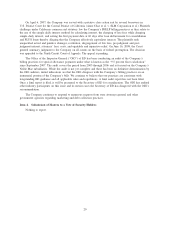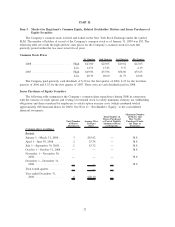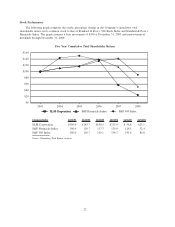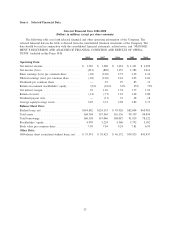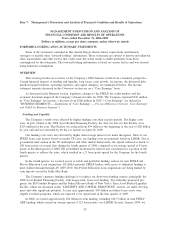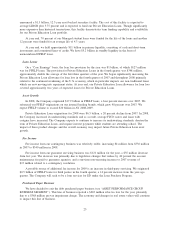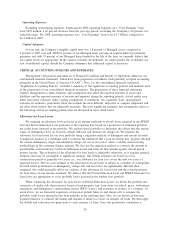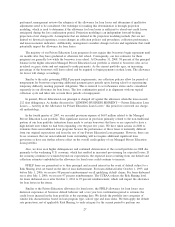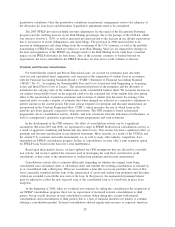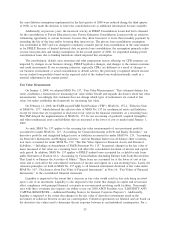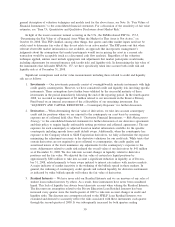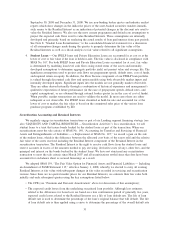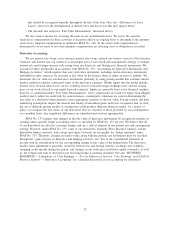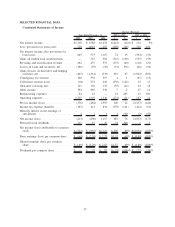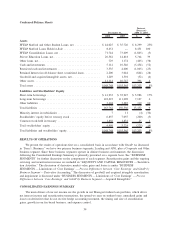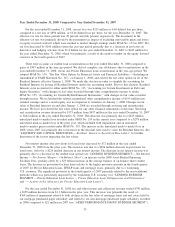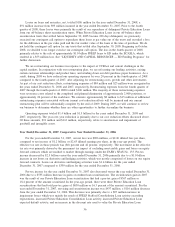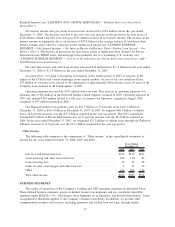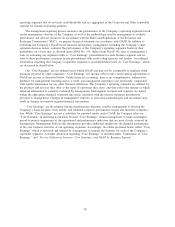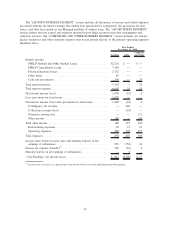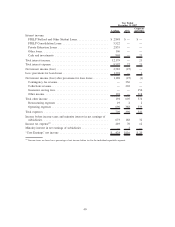Sallie Mae 2008 Annual Report Download - page 31
Download and view the complete annual report
Please find page 31 of the 2008 Sallie Mae annual report below. You can navigate through the pages in the report by either clicking on the pages listed below, or by using the keyword search tool below to find specific information within the annual report.general description of valuation techniques and models used for the above items, see Note 16, “Fair Values of
Financial Instruments,” to the consolidated financial statements. For a discussion of the sensitivity of fair value
estimates, see “Item 7A. Quantitative and Qualitative Disclosures about Market Risk.”
In light of the recent economic turmoil occurring in the U.S., the FASB released FSP No. 157-3,
“Determining the Fair Value of a Financial Asset When the Market for That Asset is Not Active,” on
October 10, 2008. This FSP clarified, among other things, that quotes and other market inputs need not be
solely used to determine fair value if they do not relate to an active market. The FSP points out that when
relevant observable market information is not available, an approach that incorporates management’s
judgments about the assumptions that market participants would use in pricing the asset in a current sale
transaction would be acceptable (such as a discounted cash flow analysis). Regardless of the valuation
technique applied, entities must include appropriate risk adjustments that market participants would make,
including adjustments for non-performance risk (credit risk) and liquidity risk. In determining the fair value of
the instruments that fall under SFAS No. 157, we have specifically taken into account both credit risk and
liquidity risk as of December 31, 2008.
Significant assumptions used in fair value measurements including those related to credit and liquidity
risk are as follows:
1. Investments — Our investments primarily consist of overnight/weekly maturity instruments with high
credit quality counterparties. However, we have considered credit and liquidity risk involving specific
instruments. These assumptions have further been validated by the successful maturity of these
investments in the period immediately following the end of the reporting period. In the fourth quarter
2008, we recorded an impairment of $8 million related to our investment in the Reserve Primary
Fund based on an internal assessment of the collectability of our remaining investment. See
“LIQUIDITY AND CAPITAL RESOURCES — Counterparty Exposure” for further discussion.
2. Derivatives — When determining the fair value of derivatives, we take into account counterparty
credit risk for positions where we are exposed to the counterparty on a net basis by assessing
exposure net of collateral held. (See Note 9, “Derivative Financial Instruments — Risk Management
Strategy,” to the consolidated financial statements for further discussion of our derivative agreements
and their policy to require legally enforceable netting provisions and collateral agreements.) The net
exposure for each counterparty is adjusted based on market information available for the specific
counterparty including spreads from credit default swaps. Additionally, when the counterparty has
exposure to the Company related to SLM Corporation derivatives, we fully collateralize the exposure
minimizing the adjustment necessary to the derivative valuations for our credit risk. While trusts that
contain derivatives are not required to post collateral to counterparties, the credit quality and
securitized nature of the trusts minimizes any adjustments for the counterparty’s exposure to the
trusts. Adjustments related to credit risk reduced the overall value of our derivatives by $41 million
as of December 31, 2008. We also take into account changes in liquidity related to derivative
positions and the fair value. We adjusted the fair value of certain less liquid positions by
approximately $201 million to take into account a significant reduction in liquidity as of Decem-
ber 31, 2008, related primarily to basis swaps indexed to interest rate indices with inactive markets.
A major indicator of market inactivity is the widening of the bid/ask spread in these markets. In
general, the widening of counterparty credit spreads and reduced liquidity for derivative instruments
as indicated by wider bid/ask spreads will reduce the fair value of derivatives.
3. Residual Interests — We have never sold our Residual Interests and we are unaware of any sales of
student loan residual interests by others. As a result, these instruments have never been considered
liquid. This lack of liquidity has always been taken into account when valuing the Residual Interests.
The discount rate assumption related to the Private Education Loan Residual Interests has been
increased every quarter since the fourth quarter of 2007 to take into account changes in credit and
liquidity risks. The discount rate assumption related to the FFELP Loan Residual Interests was
examined and deemed to accurately reflect the risks associated with these instruments each quarter
through the second quarter of 2008. It was subsequently increased for both quarters ending
30


